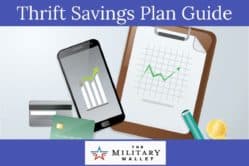For those of us who have ever sifted through our daily emails and realized that we never subscribed to half of the messages in our inbox, the concept of automatic enrollment is quite familiar. In order to stop receiving advertisements, sales notifications, or updates from stores or websites that we visited one or more times, the burden is placed upon the individual to hit “unsubscribe.”
Numerous studies have demonstrated the effectiveness of automatic enrollment in retirement accounts such as 401(k) plans and the Thrift Savings Plan (TSP). The TSP’s automatic-enrollment feature has numerous benefits that outweigh its costs. Here’s what you need to know about it.
What Is TSP Automatic Enrollment?
The TSP is the U.S. government’s long-term retirement savings and investment plan for federal employees, including members of the military. It is similar to 401(k) plans available across the private sector.
TSP automatic enrollment automatically integrates newly hired federal employees (those under the Federal Employees Retirement System, or FERS) and military members under the Blended Retirement System (BRS) into the Thrift Savings Plan program.
The government instituted automatic enrollment in August 2010, and it has dramatically increased the number of people participating in TSP and helped federal employees and service members capitalize on employer matching contributions
Automatic enrollment helps individuals increase their retirement savings by “nudging” them into saving.
Newly hired federal workers and service members can opt out of the TSP if they do not wish to contribute.
Impact of the TSP Auto-Enrollment Program
The Congressional Budget Office (CBO) released a study showing the impact the TSP auto-enrollment (AE) program had on plan participation, contribution as a percentage of salary and other factors. The results were positive across the board.
| TSP Behavior | Hired Before AE (Hired between August 2009 and July 2010) | Hired After AE (Hired between August 2010 and July 2011) |
|---|---|---|
| Percentage of workers who contribute | 60.0 | 96.7 |
| Average contribution rate (As a percentage of salary) | 2.9 | 4.4 |
| Average contribution rate for those who contributed (As a percentage of salary) | 4.8 | 4.5 |
| Percentage of workers whose whole portfolio is invested in the G Fund | 76.0 | 79.7 |
| Pecentage of workers’ portfolio invested in the GFund | 84.3 | 85.5 |
| Average ratio of balance to pay | 0.2 | 0.2 |
| Sample Size | 51,732 | 53,386 |
This table covers the period just prior to and just after the auto-enrollment program began for the FERS retirement system. The default contribution at this time was 3%, and the default investment fund was the G Fund.
You will notice a large percentage of the participants left their investments in the G Fund. In 2020, TSP increased automatic contributions from 3% to 5% and changed the default fund from the G Fund to the most appropriate lifecycle fund, based on the participant’s age.Changes to TSP Automatic-Enrollment Percentages
Changes to TSP Automatic-Enrollment Percentages
When the government rolled out automatic enrollment in 2010, newly hired (or rehired) civilian federal workers had 3% of their salary each pay period directly deposited into their individually held TSP accounts. The U.S. military employed the same practice several years later when the Blended Retirement System was introduced: Service members who began serving on or after Jan. 1, 2019, were also automatically enrolled in TSP, with 3% of their pay deducted from their paychecks after their first 60 days.
However, the Federal Retirement Thrift Investment Board (FRTIB) – the agency that oversees TSP – announced in Feb. 2020 that it would increase the automatic-enrollment percentage from 3% to 5% of pay for all participants who automatically enrolled in the TSP on or after Oct. 1, 2020.
Service members and federal workers can change or halt TSP contributions altogether, and request refunds for contributions they did not wish to make.
Why Change the TSP?
The logic of increasing the TSP automatic enrollment percentage from 3% to 5% is two-fold.
First, it makes it easier for people to save for retirement without trying and benefit from investing more at a younger age.
Second, federal workers under the Federal Employees Retirement System (FERS) and service members under the BRS are eligible to receive up to 5% in matching contributions from their agency or service every pay period.
Military members who are not in the BRS do not receive matching TSP contributions. Military members who are in BRS must complete two years of service before they are eligible to receive service-matching contributions
With automatic enrollment set at 5%, participants can fully capitalize on matching contributions without taking any action; the agency or service automatically matches up to 4% of a participant’s basic pay plus an additional automatic 1% contribution (4% + 1% = 5% matching).
If you opt-out of the TSP altogether, you can no longer receive matching contributions, leaving free money on the table.
| Your Contribution | Automatic 1% Contribution | Agency Matching Contribution | Total Contributions |
|---|---|---|---|
| 0% | 1% | 0% | 1% |
| 1% | 1% | 1% | 3% |
| 2% | 1% | 2% | 5% |
| 3% | 1% | 3% | 7% |
| 4% | 1% | 3.50% | 8.50% |
| 5% | 1% | 4% | 10% |
| More than 5% | 1% | 4% | Your Contribution + 5% |
How Are Automatic Enrollments Invested?
Unless a TSP participant specifically selects investment funds, the full amount of their automatic enrollment percentage (currently 5%) will be deposited in the lifecycle fund (L Fund) deemed most appropriate for their age. Previously, funds were deposited into the G Fund.
Lifecycle funds can be a good option for novice investors or those most comfortable with set-it-and-forget-it investment strategies. Investors simply select a target date for retirement, and the fund’s managers do the rest.
TSP participants who prefer to have a more active role in managing their investments can select individual or lifecycle funds on the TSP website or by calling 1-877-968-3778. Participants can also redistribute their existing TSP account balance by requesting an interfund transfer, although they are limited to two transfers per month.
Benefits of Increasing Your Auto-Enrollment Amount
While contributing 5% per pay period is an excellent start to saving for retirement, investing more now can help you join the TSP Millionaires club.
While contributing 5% of your earnings per pay period will maximize the U.S. government’s matching contribution, contributing more than 5% maximizes the benefits of compound interest – what Albert Einstein coined the eighth wonder of the world.
Over time, even small, regular contributions to your retirement account can yield big payoffs. This article covers more information about maximizing your TSP plan.
Keep in mind that there are annually established contribution limits for TSP accounts. In 2023, individuals can contribute up to $22,500 to their TSP accounts, and participants who are aged 50 and older can contribute an additional $7,500 (a “catch-up” contribution).
To determine what automatic-enrollment percentage will help you reach the maximum amount without exceeding the limit, you can use a TSP calculator with information from your pay statements.




About the comments on this site:
These responses are not provided or commissioned by the bank advertiser. Responses have not been reviewed, approved or otherwise endorsed by the bank advertiser. It is not the bank advertiser’s responsibility to ensure all posts and/or questions are answered.